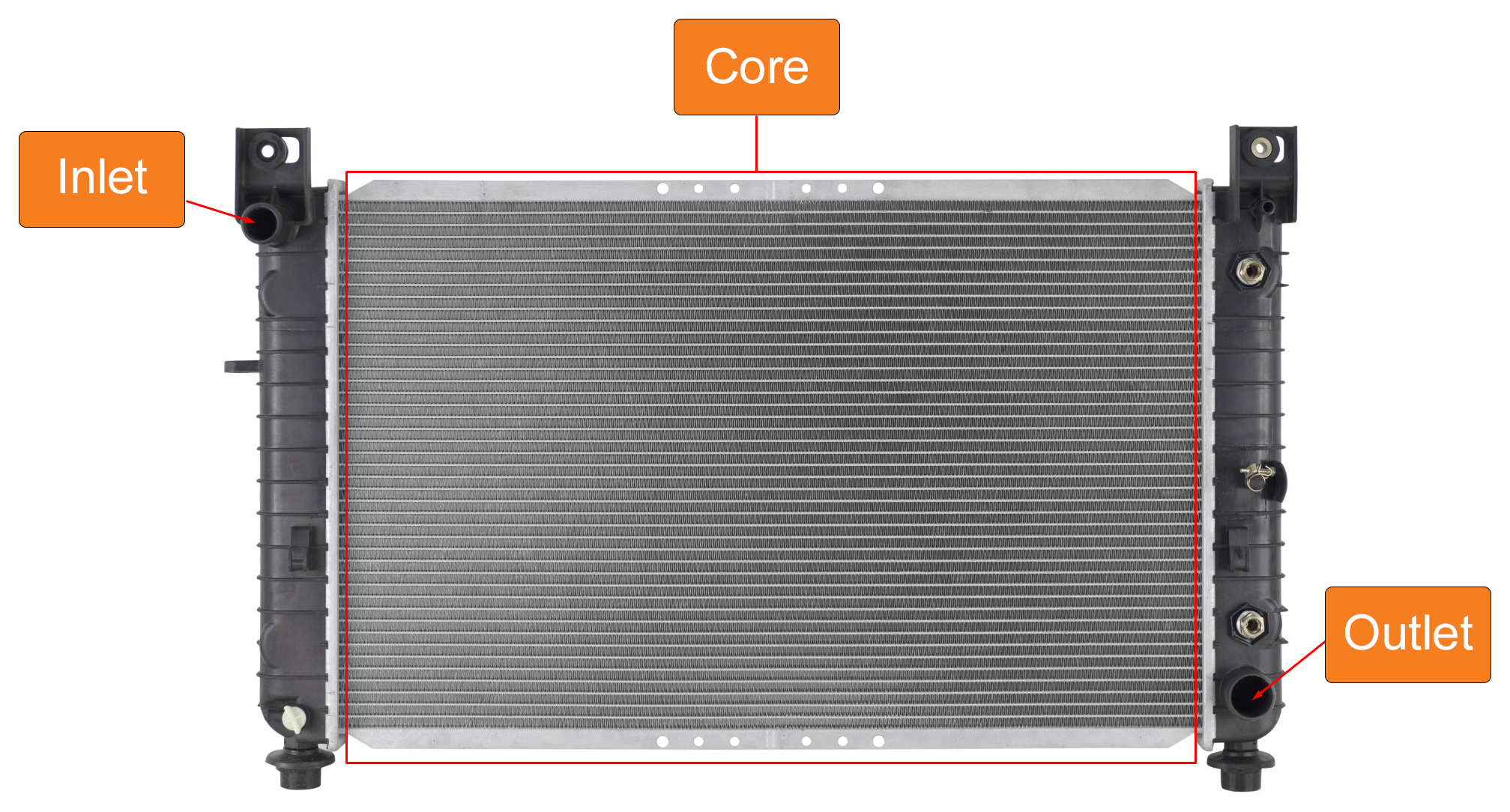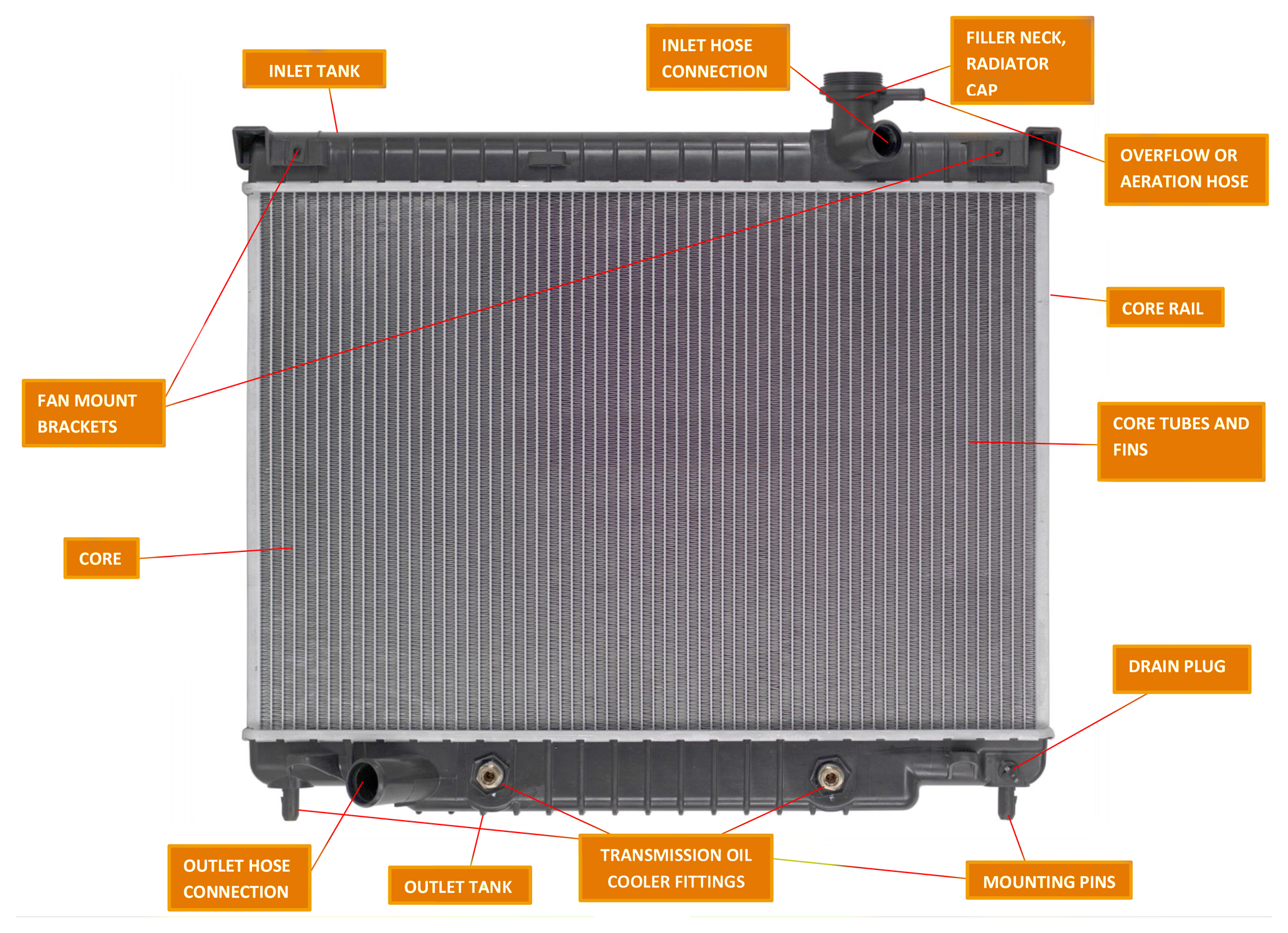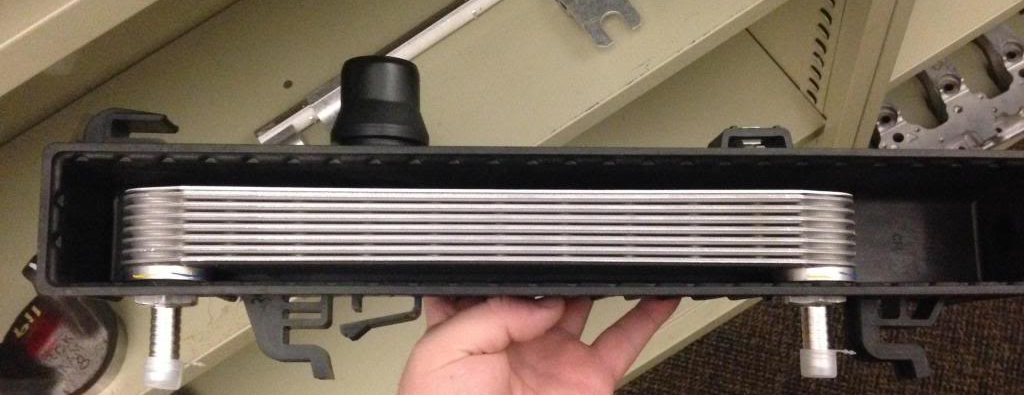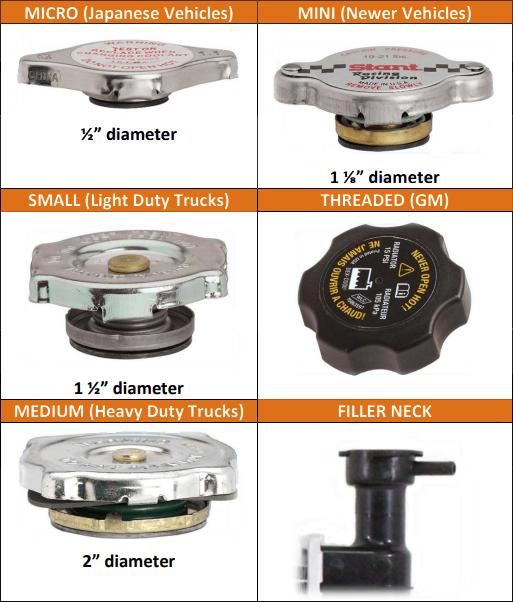PARTS OF A RADIATOR
If you are on Parts Nation, chances are you are trying to decide on a new radiator for your car. Understandable.
When you have a bad radiator, your car will potentially overheat, leaving you stranded in the middle of nowhere on that long road trip. And if you weren’t in a bad enough spot already, a poorly functioning radiator might just destroy your engine. On the bright side, it would make for great family conversation once you have finally made it to your intended destination (in retrospect, of course).
What do you need a radiator for?
Your typical combustion engine generates a lot of heat to burn gas that turns the pistons to move the car. The radiator’s main purpose is to act as the heat exchange for that engine, transferring heat to the cooler air outside. Coolant cycles between the radiator and the engine block to absorb excess engine heat. When that same coolant returns to the radiator, the radiator’s tubes and fins help expose more of the coolant to the surrounding air. After passing through the radiator, coolant recirculates back to the engine.
You know… those cars by the side of the road with smoke coming out the engine. Those people probably blew a radiator.
To cool your engine, you need coolant, and something to cool the coolant as well. This is vital to for the lifespan of your engine so that it does not overheat (and potentially explode, which would be terrible).
What makes up a Radiator?
A radiator comes in many shapes and sizes; however, they all have the same function and components.
Every radiator has these main components:
Core:
The core is the largest section of the radiator and is where the cooling takes place. This portion is made of metal, usually aluminum. It is easily recognizable from the rows of narrows tubes and fins (teeth-shaped metal pieces) going down or across it.
You may come across either a 2-row or 2-core, or 3-row or 3-core radiators. Those radiator rows refer to the number of flat tubes adjacent to each other on the radiator’s core. More rows allow more coolant to flow between the tubes and fins, allowing more heat transfer. Larger vehicles sometimes require thicker cores with more rows, hence, the more rows on the radiator, the thicker the core becomes.
Hose Inlet and Outlet:
Hot coolant flows from the engine through the inlet hose, enters the core, and releases heat to the surrounding air before being returned to the engine through the outlet hose. The upper inlet hose connects the top of the radiator to the top of the engine. The lower outlet hose connects to the bottom of the radiator to the water pump of the engine. Older vehicles may have aluminum or brass tanks that are welded directly to the core. Newer radiators use plastic tanks that are connected to the aluminum core by metal tabs and rubber seals. The plastic/aluminum construction is currently the most popular, as it is the most cost-efficient and lightweight option available.

Standard radiator with hose inlet on the top right (passenger) side, and the hose outlet on the bottom left (driver) side.
Some radiators may also have additional features, such as a drain, a built-in transmission cooler, a filler neck, and coolant sensors:

A radiator with the inlet/outlet going top-to-bottom, with a filler neck, and with transmission cooler fittings on the bottom.
Drain plug:
A radiator with one of these makes removing coolant relatively easy. There is no need to dismantle any hoses. Pro-tip: Just remember to plug it back in securely or you will spring a leak.
Built-in transmission cooler:
Most (if not all) automatic transmission vehicles have a cooling line attached to the radiator. A separate series of cooling tubes can be found inside the outlet radiator tank, which circulate and cool transmission fluid with the radiator coolant. This keeps your transmission operating at the optimal temperature. If you plan to tow extra weight however, it is recommended that you also use an additional transmission cooler to keep from overheating.

There are two major categories of transmission cooler fittings -- integrated and detachable. Integrated fittings should not be removed. This will cause issues with your transmission cooler and will make it difficult to put back together. In some cases, the transmission cooler will detach from the tank and sink, making it irretrievable. Detachable fittings are, as the name implied, easily detachable from the radiator.
In addition to the two types of fittings, there are several different connection types depending on your vehicle’s make and model which may cause confusion to individuals. You may have a threaded fitting in which you need to unscrew the transmission lines. You may also have quick connect fittings, which allow you to simply pull out the transmission lines easily.
Filler Neck:
This is an opening on top of your radiator. This is similar to the drain plug, except this makes adding coolant to your cooling system much easier. It is covered by a pressure cap, which opens when internal fluid pressure exceeds capacity. This allows heat to escape and let excess coolant fluid overflow into reservoir tanks on either side of the radiator.
Radiator caps come in various sizes:

Radiator Failure:
To prevent radiator failure, it is recommended to have your vehicle serviced by a professional technician or mechanic. A few tips to help you keep your radiator in optimum condition:
- Always use the right coolant. Different vehicles may require different compositions of coolant. Radiators constructed from different materials may require different coolant types.
- Check coolant levels regularly. Monitoring your coolant at regular intervals allows you to determine whether you have a leak. If you find yourself using more and more coolant as time goes on, there is probably a defect in your radiator.
- Have your radiator flushed. Doing a radiator flush every 25,000 miles or every few years removes any contaminants built up inside the radiator. It also prevents components from rusting.
- Maintain your hoses and check for leaks. If you notice any cracks in your radiator hose, or notice it starting to dry out, it’s time for a hose replacement. Keep up to speed on the small components of your cooling system, so you do not have to replace the entire thing later on.
- Do not overload your vehicle; especially if you tow things around often. If you regularly tow a trailer or anything else, make sure your entire cooling system is set up correctly and includes all the components you need, including any transmission coolers, engine oil coolers, or intercoolers.
If you start noticing anything abnormal, such as your temperature gauge rising too slowly or too quickly, or smoke coming out of the engine bay, or if you discover coolant collecting under your vehicle, have your vehicle brought to the mechanic so they can diagnose any issues.
Being stuck on the side of the road is the last thing anybody wants. If in the event your car ends up getting towed to a mechanic because of that radiator, Parts Nation offers over 2,600 different radiators, each built to meet your cooling needs! All our radiators are complete with superior materials and are manufactured using advanced equipment operated and tested by experts in the automotive industry. Our quality is never compromised! We also offer a 1-year warranty on all of our items in the rare event you experience an issue with your new radiator. We ship both the U.S. and Canada, and any other place in the world so long as you have an address. Feel free to contact us today to determine which radiator is the best for your vehicle!


 US Dollars
US Dollars
 Canadian Dollar
Canadian Dollar



